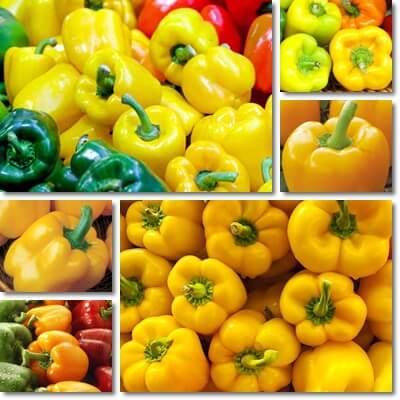Yellow bell peppers are variety of sweet pepper that ripens to a yellow color. The yellow bell pepper is the richest in vitamin C of all colors, with one large fruit providing roughly 4 times the daily requirement of the vitamin for an adult person. A good food source of vitamins B3 and B6, it holds benefits for fatigue and helps bring down LDL cholesterol levels.
Low in calories, carbs and fat, it’s a good food to consider for healthy weight loss diets. In addition to beta-carotene and vitamin C, the variety is a good source of the mineral manganese with important antioxidant properties. Yellow bell peppers are especially good for collagen production for better skin elasticity and contribute to a strong, healthy immune system.
What do yellow bell peppers taste like?
Yellow bell peppers taste moderately sweet, with strong, non-pungent pepper flavors. Given they’re a sweet pepper variety, they lack the pungent capsaicinoid compounds that make chili peppers spicy. If unripe or not yet fully ripe, they may also taste bitter, especially the green parts. But normally, yellow bell peppers are not bitter, just moderately sweet. They are comparably less sweet-tasting than red ones, but sweeter than white. They have a pleasantly crisp, thick, meaty flesh.

What do yellow bell peppers look like?
Medium to large size, bulky-looking and hollow inside, with 3 or 4 lobes at the base. Initially green, they ripen to a uniform golden yellow color given to them by pigmented beta-carotene and other carotenoid antioxidants. Both the skin and flesh become yellow.
If the peppers are not fully ripe, then there may also be some green on them. Of course, at the supermarket you’ll likely find only uniform-colored yellow bell peppers. But know that it’s perfectly okay if they are also slightly green – it just mean they haven’t ripened completely.
The skin is shiny, almost waxy and smooth to the touch. The peppers have a thick, meaty, crisp flesh. Inside, towards the stem, there is a white, spongy pulp to which dozens of roundish, flat, creamy white seeds are attached. If you collect the seeds and plant them and water regularly, you’ll be growing your own fruit in no time.
Uses and recipe ideas
There are so many uses for yellow bell peppers in the kitchen. They are great eaten raw in salads such as a East European-inspired red, green, purple, orange and yellow bell pepper salad with onion, sunflower oil and feta cheese, seasoned with thyme and oregano. Plainly roasted and dipped in a crushed garlic, salt and water sauce. Sliced and sauteed with green beans or yellow string beans, onions and sweet corn. Or you can make a delicious fried onion and roasted yellow bell pepper cream soup, seasoned with salt, white pepper, thyme and oregano and dressed with sour cream. Other classic recipes to try include yellow bell pepper cream soup with potatoes or sweet corn or zucchini or yellow tomatoes. Yellow bell pepper can even be used for baby food, but the peppers should be from organic agriculture since babies and small children are more sensitive to toxins and pesticides in food.

Nutrition facts of Yellow Bell Peppers for 100 g
- Energetic value: 27 kilocalories
- Carbohydrates: 6.3 g of carbs
- Sugars: data not available
- Dietary fiber: 0.9 g
- Fat: 0.21 g
- Protein: 1 g
- Vitamins content
- Vitamin A (RAE, retinol activity equivalent): 10 micrograms/mcg as beta-carotene (120 mcg)
- Vitamin B1: 0.028 mg
- Vitamin B2: 0.025 mg
- Vitamin B3: 0.89 mg
- Vitamin B5: 0.168 mg
- Vitamin B6: 0.168 mg
- Vitamin B9: 26 mcg
- Vitamin B12: 0 mcg
- Vitamin C: 184 mg
- Vitamin D: 0 mcg
- Vitamin E: data not available
- Vitamin K: data not available
- Minerals content
- Calcium: 11 mg
- Copper: 0.107 mg
- Iron: 0.46 mg
- Magnesium: 12 mg
- Manganese: 0.117 mg
- Phosphorus: 24 mg
- Potassium: 212 mg
- Selenium: 0.03 mcg
- Sodium: 2 mg
- Zinc: 0.17 mg
Macro-nutrient profile. According to the macro-nutrient profile, yellow bell peppers are relatively low in carbs, with only 6.3 g per 100 g (3.5 oz) and extremely low in fat (0.2% fat). Moreover, they have a low energetic value, with a calorie content of only 27 kilocalories per 100 g (3.5 oz), which makes them a good food for weight loss. It’s not just calorie count or carb count when it comes to healthy weight loss, but also nutritional content and the variety is nutritious, being a varied source of essential vitamins and minerals.
Yellow bell peppers vitamins. Yellow bell pepper vitamin C content is highest of all colors: 184 mg per 100 g (3.5 oz). Red ones have 127.7 mg of vitamin C, while green ones have only 80.4 mg. The average adult requires a minimum of 75 mg of vitamin C a day (women) and 90 mg (men), and one large yellow pepper at 3-3/4 inches long and 186 g weight provides 341 mg of vitamin C, roughly 4.5 times and 3.7 times the vitamin C requirement. The variety is also a good source of vitamin B3, with 0.89 mg per 100 g (3.5 oz) – roughly 5.5% of the recommended daily intake of the vitamin for an average adult man, and 6.3% for an average adult woman. Only 100 g of yellow bell pepper provides close to 8% of the recommended daily intake of vitamin B6.
Minerals in yellow bell pepper. The variety is a good source of dietary potassium, with 212 mg per 100 g (3.5 oz), which is 4.5% of the recommended daily intake, and an even better source of the antioxidant mineral manganese, with roughly 9.5% of the recommended daily intake of manganese for adult men and 12% for women. Otherwise, mineral content in yellow bell peppers is poor – the only advantage being the extremely low sodium content, 2 mg per 100 g (3.5 oz), which makes them a good food to eat for high blood pressure.
Other relevant nutrition facts. Yellow bell peppers have no vitamin D and no vitamin B12, but contain trace amounts of selenium, vitamins A, B9, E and K (the vitamin E and vitamin K content are not determined for this color variety, according to Food Data Central).
What are the benefits of Yellow Bell Peppers?
Yellow bell peppers hold important benefits for the skin and the immune system and exert antioxidant and anti-inflammatory properties. They are a good food to eat for healthy weight loss, as well as good for diabetes seen they have a low glycemic index and low glycemic load. Other minor benefits include benefits for eyesight, digestion, notably constipation relief, but also high blood pressure, high cholesterol, fatigue and anemia. See the list of benefits below:
- Eating yellow bell peppers boosts the immune system thanks to their high vitamin C content.
- Antioxidants benefits: vitamin C, manganese and the pigmented beta-carotene antioxidant giving yellow bell peppers their color scavenge free radicals and prevent and help repair cell damage.
- Anti-aging properties: vitamin C stimulates collagen production in the skin for improved skin elasticity, exerts anti-inflammatory properties, promotes wound healing and protects skin cells from oxidative stress and its aging effects.
- Other benefits for skin from vitamins B3 and B6 and, to a lesser extent, B1, B2 and B5, which prevent inflammation, reduce infection risks and actively contribute to skin health.
- Vitamin B3 contributes to lower LDL (bad) cholesterol and triglyceride levels and higher HDL (good) cholesterol levels.
- Good food to eat for high blood pressure thanks to a good potassium content and extremely low sodium content.
- Yellow bell peppers are a good food to eat for diabetes thanks to their low glycemic index (GI estimated at 30-40) and an even lower glycemic load (GL estimated at 2-2.5 for a serving of 100 g).
- Vitamin C enhances absorption of iron for reduced fatigue and increased vitality, while B vitamins elevate energy levels.
- Anti-anemia food: has rich amounts of vitamin C to up iron absorption, good amounts of vitamin B6 for the synthesis of heme, a component of hemoglobin in red blood cells.
- Minor benefits for eyesight from limited amounts of vitamin A from beta-carotene antioxidants.
- Good food to eat for weight loss due to a low calorie, fat and carbohydrate content.
- Benefits for relieving constipation thanks to dietary fiber content.
What are the side effects of Yellow Bell Peppers?
- Yellow bell peppers allergy. Although not a common allergen, the fruit has the potential to trigger an allergic reaction that can build up to anaphylactic shock, which is a medical emergency. Avoidance in all forms and preparations is the only solution.
- Bad for gastritis. Yellow bell peppers and all other sweet pepper color varieties can be a trigger food for gastritis (as much as garlic, onions, coffee or chocolate). Eating them can result in stomach upset and flare up gastritis symptoms. Find out more about what foods to eat and to avoid for gastritis.
- Bad for acid reflux. If you have acid reflux disease, or GERD, or a condition that makes acid reflux more likely, such as a hiatal hernia or pregnancy, then know that yellow bell peppers might be a trigger food. Symptoms may include excessive burping, with burps that smell like pepper and taste acidic (a signs of stomach contents escaping into the esophagus), heartburn, nausea, vomiting and general stomach upset. Find out more about what foods to eat and to avoid for acid reflux.
- Indigestion. All peppers, sweet or spicy, can cause digestive upset. Eating too many at once or having them too often can result in indigestion with bloating, burping that smells like peppers and tastes acidic, cramps, flatulence, belly button pain or pain in the middle of the abdomen or in the right abdomen, even loose stools, nausea and vomiting, malaise and insomnia.
